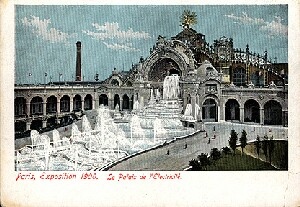|
1 2 3 4 5 |
 Copyright: Kraemer 1900, o.S. |
Visitors to the Paris exposition of 1900 were amazed not so much by the architectural innovations as by the sophisticated theatrical means of creating illusions. These included the streets designed to create grand perspective, or building complexes which played with the perception of size and distance.
From Paulin's water palace sprang a waterfall, flowing against the backdrop of a lavishly ornamented reinforced concrete facade into various small tubs located in a broad basin to set off water attractions. Plastic human and animal figures animated the artificial rocks and grottos. Close behind this spectacle, which was illuminated at night, was the Palais de l'Electricité‚ which was crowned by an iron structure of stars shining out to all sides. The daytime perspective effect was intensified by electrical illumination at night and, together with the illuminated water effects, transformed the Champs de Mars into an atmospheric sea of light. Inside, this atmosphere was resumed in a hall of illusions, whose vault appeared to extend infinitely in all directions - an effect achieved by the use of electrical lighting, perspective painting and mirrors. The machine hall also featured a lavishly decorated assembly hall whose ground plan and style of construction was reminiscent of a giant circus tent, with a large, multicoloured glass dome which painted the room in coloured light during the day, too.
While artists at the close of the 19th century were already experimenting with new visual or scenic languages which represented a radical departure from the imitation of reality with the aid of means of illusion, the entire world exposition was one baroque stage full of theatrical effects to provide the visitor with emotional experiences. Frivolities such as the upside-down house - "le manoir l'envers" - clearly showed that the initial plans for an educational event had given way to a full-scale fun fair geared primarily to providing entertainment and short-lived attractions for a sensation-seeking public.
For the most part, the technical innovations were employed to create an artificial other-worldly atmosphere by means of kaleidoscopic impressions. A vivid model was even found for the universe, on the square in front of the Eiffel Tower. Three spheres of 46, 36 and 8 metres diameter enclosed one inside the other produced a giant globe installed in a structure of 60 metres in height. The outer layer of this globe symbolised the universe, the middle layer the stellar system and the inner layer the earth. Via a spiral staircase, visitors were able to climb up to the North Pole, from where they could enjoy a view of the painted, but nevertheless moving, firmament, to the accompaniment of celestial organ music by Saint-Saëns. A mechanical construction which moved the spherical shells in relation to one another in accordance with the planetary orbits was responsible for the kinetic effect.
However, one project demonstrated the actual limits of the apparently endlessly entertaining illusory gimmicks. On the basis of drawings and paintings, it was intended to enable the visitors to take a walk through the "old Paris" of four hundred years previously, along the banks of the Seine. This high-handed presumption to rebuild history with modern scenery - to exhibit a historical city within the city - was highly questionable in both political and aesthetic terms, as was the unscrupulous appropriation of foreign lands and cultures in staging the colonial exhibition in front of the Trocadero with plaster copies of famous mosques. The idea of enhancing a conventional world exposition at the beginning of the 20th century, signalling the emergence of new means and methods of communication, was submerged in a bombastic, thoughtless dissipation of energy. Contemporary criticism was already forecasting the death of the idea of the world exposition - it was time to find a new concept for the great international exhibitions.
| Year: 1900 | City: Paris | Country: France |
| Duration: 15th April - 12th November 1900 | ||